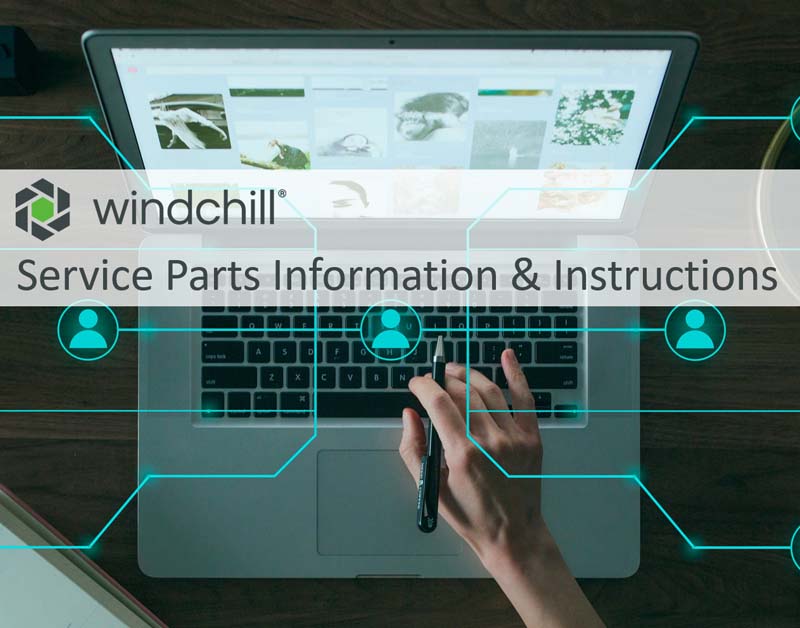About Windchill SPII
Manage Context-Specific Service Information
Manage context-specific service information to facilitate information reuse, streamline change management and enable delivery of configuration-based technical publications.
Create service BoM to deliver high-quality spare parts information.
The Windchill Service Parts Information and Instructions improves service operations efficiency and effectiveness by enabling service information to be organized and optimized for accuracy, applicability, and rich, graphics-driven delivery.
Order or Request a Quote
Download Product Information
Key Benefits of Windchill SPII
To Service Organisation
- Improve revenue for service parts
- Increase technician productivity
- Reduce turnaround times
To Enterprise
- Increase company & service profit
- Ensure customer value
- Increase service efficiency
To Customer
- Faster service resolution times
- Higher equipment uptime and productivity
- Increased customer satisfaction through product performance
To the Service Information Department
ENHANCE SERVICE INFORMATION RELEVANCE
- Define Applicability and effectivity rules, so the most relevant service information is available for every product configuration and operating condition.
- Eliminate wasted time spent searching through irrelevant service content.
MAINTAIN UP-TO-DATE SERVICE INFORMATION
- Maintain associativity between engineering and service information, for facilitating impact analysis so that changes on the engineering side can be quickly integrated to service information.
- Ensure that customer service, technical support and field service operations have access to the most up-to-date service information.
- Align service content with the product definition, for contextual information of the highest accuracy and consistency.
INCREASE AUTHOR PRODUCTIVITY
- Centralize management of all service information and organize that information in a logical, product-centric manner that facilitates content reuse.
- Reduce service information authoring time.
- Facilitate content reuse and enhance content consistency across publications with the use of Publication Structures.
- Facilitate access of service engineers and authors to source engineering information.
- Automate multi-channel publishing to multiple formats.
ENHANCE SERVICE PARTS RELEVANCE
- Define Applicability rules for spares so the correct serviceable part required is available for every product configuration and operating condition.
MAINTAIN UP-TO-DATE SPARE PARTS INFORMATION
- Build associativity to engineering or manufacturing product data to ensure up-to-date serviceable parts information.
- Enhance user confidence concerning service information accuracy, given the information’s tight association with source engineering/manufacturing product definition.
INCREASE EFFICIENCY & PRODUCTIVITY OF PARTS LIST AUTHORS
- Generate Parts Lists for a system from sBOM and define catalog-specific information.
- Accelerate illustration creation by automatically generating interactive 2D & 3D representations of Parts Lists Support work-in-process collaboration.
STREAMLINE TRANSLATION MANAGEMENT
- Improve time to market through streamlined translation process, making multiple languages available without lengthy delay.
- Reduce cost through elimination of redundant and manual activities.
SIMPLIFY AND IMPROVE CHANGE MANAGEMENT PROCESSES
- With associativity, changes on the engineering parts are automatically flagged on the service side and can be quickly incorporated and reflected in updated Parts Lists.
- With an enterprise level of deployment of Windchill, Engineering can perform extensive impact analysis to assess the impact of a design change on services before authorizing/issuing the change.
Key Features of Windchill SPII
INFORMATION STRUCTURE
- Provide breakdown of a product into serviceable systems and sub-systems, typically defined at the product family or model level, to enhance content consistency and maximize content reuse.
- Define content applicability such as product options, operating conditions, serial number, date effectivity.
- Enable initial and incremental publishing and delivery of rich, interactive service information specific to product configuration Organize and manage service information pertaining to a product, whether it is PTC-created content such as illustrations, parts information, or procedures, or non-PTC-created content such as multimedia, videos, or graphics.
APPLICABILITY RULES
- Define multiple conditions (product configurations, system options and operating environments) or date and serial number effectivity information for when service content applies.
- Include/exclude the appropriate service information presented to users based on defined applicability criteria to yield product configuration-specific information.
- Enable management at multiple levels to simplify definition (e.g., system or component, specific pieces of information, content within pieces of information).
PUBLICATION STRUCTURE
- Publication structures typically represent a “manual” or a “publication” (e.g., Repair Manual, Parts Catalog) and allow users to organize service content for delivery in a print format.
- Author Publication Structures by leveraging the organization of content in Information Structures. For example, a user can generate a publication structure for a specific serial number or a language.
- Leverages Windchill structure management capabilities and the dynamic publishing capabilities of PTC Arbortext Publishing Engine™ to create product configuration-specific service manuals.
- Content represented by the Publication Structure can be published for various print formats like PDF and electronic formats such as Arbortext Content Delivery bundles.
- Facilitate content reuse and enhance content consistency across publications using Publication Structures, which can be initiated from templates, reused in their entirety, or in parts combined with other products or publication structures.
TRANSLATION MANAGEMENT
- Manage translation process of reusable service information topics for automated publishing of language-specific content.
- Automatic detection, extract and load of objects needing translation by language.
- Support multiple translation vendors.
- Maintain associativity of translation content to source language content.
PRODUCT HIERARCHY
- Represents hierarchical organization of serviceable products generally organized into product families, categories/types and specific models that allows a technician to navigate and find the right, contextual service information in the Arbortext Content Delivery environment.
- Capture additional information such as metadata and graphics using the product hierarchy nodes, which provide the context for the service information.




